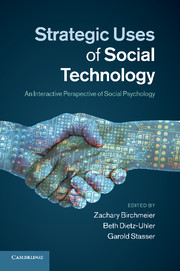Book contents
- Frontmatter
- Contents
- Figures
- Tables
- Notes on the contributors
- Acknowledgments
- 1 Introduction
- 2 A SIDE look at computer-mediated interaction
- 3 Trust, deception, and identity on the internet
- 4 An interactional approach to social influence in computer-mediated communication
- 5 Social interaction in cyberspace
- 6 Dynamics of leader emergence in online groups
- 7 Ostracism in cyberspace
- 8 Opinion-based groups
- 9 A juxtaposition of social influences
- 10 The virtual social world
- Index
- References
6 - Dynamics of leader emergence in online groups
Published online by Cambridge University Press: 07 October 2011
- Frontmatter
- Contents
- Figures
- Tables
- Notes on the contributors
- Acknowledgments
- 1 Introduction
- 2 A SIDE look at computer-mediated interaction
- 3 Trust, deception, and identity on the internet
- 4 An interactional approach to social influence in computer-mediated communication
- 5 Social interaction in cyberspace
- 6 Dynamics of leader emergence in online groups
- 7 Ostracism in cyberspace
- 8 Opinion-based groups
- 9 A juxtaposition of social influences
- 10 The virtual social world
- Index
- References
Summary
Communication technologies and the internet have created an explosion in the number and types of groups that exist in contemporary society – some of which could not have been imagined twenty years ago. The ubiquitous range of information and communication technologies (from hand-held devices to laptops to videoconference rooms to virtual reality immersion labs) provides a variety of channels (audio, video, text, tactile, and graphics in two and sometimes three dimensions) and functionality (communication, collaboration, file sharing, social networking, etc.) which has enabled groups to move beyond the conventional “same time, same place” model of face-to-face groups to an “anytime, anywhere” or even an “all the time, everywhere” model of the digital world (Hollings-head and Contractor, 2002). Some types of online groups, which were novel fifteen years ago, are now commonplace, such as geographically distributed work teams and internet-based discussion forums and online communities.
With the advent of Web 2.0 and Web 3.0 on the horizon, new group forms are continually emerging. Facebook, MySpace, and other social networking sites have enabled people with common acquaintances, similar interests, or complementary goals from across the country or around the world to connect and, in some cases, form discussion groups, friendship groups, political action groups, and even business ventures. Some multiplayer online games, such as “World of Warcraft,” are organized around “guilds” and players must work as a team to overcome obstacles and achieve goals. Virtual worlds, such as Second Life, are user-defined and user-created environments where “residents” can explore, meet other “residents,” socialize, participate in individual and group activities, and conduct business (Wikipedia, 2008).
- Type
- Chapter
- Information
- Strategic Uses of Social TechnologyAn Interactive Perspective of Social Psychology, pp. 108 - 126Publisher: Cambridge University PressPrint publication year: 2011
References
- 1
- Cited by

